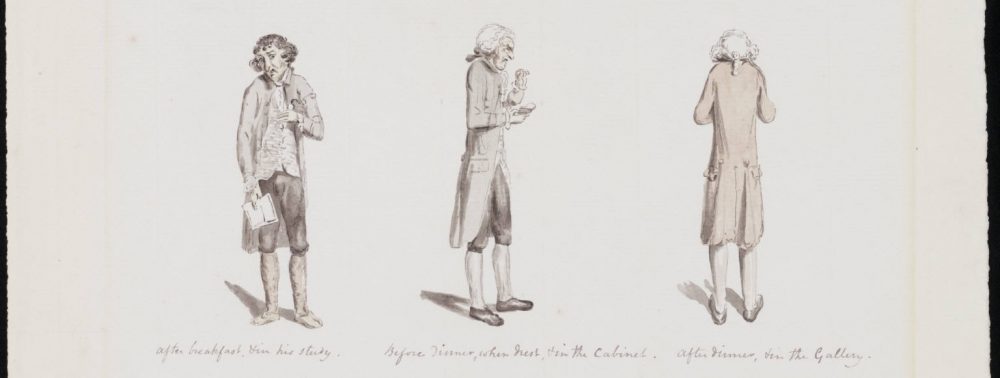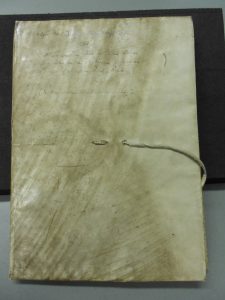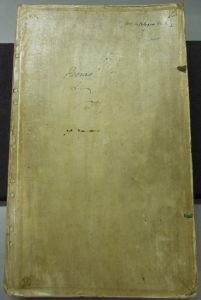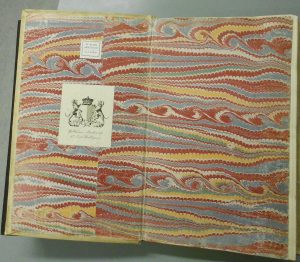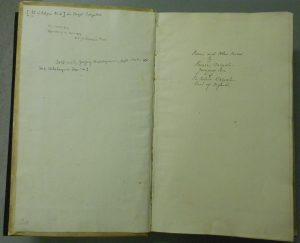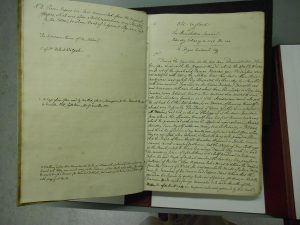Choice 4: Walpole’s Three “Common Place Books,” Two “Books of Materials,” “Miscellany,” and Pocket Book
“These seven manuscripts are being saved on the generous principle that permits the rescue of an entire set and not just its first volume. If the Almighty objects, ‘This is going too far!’, I’ll choose the earliest one, for which Walpole wrote a title-page, ‘Verses, Stories, Characters, Letters, etc. etc. with some particular memoirs of a certain Parcel of People. 1740.’
“The three vellum-bound folio Common Place Books were left by Walpole to the Waldegrave family and stayed at Strawberry Hill. They were kept out of the 1842 sale, but were sold the following year to Richard Bentley the publisher (not to be confused with Gray’s and Walpole’s Bentley), along with the manuscripts I talk about in Choices 1 and 15. Grandfather Bentley sold back the Common Place Books in 1865 to the widow of the seventh Earl, Frances Lady Waldegrave, who restored the splendors of Strawberry by two later brilliant marriages and her own social gusto. In 1942 when I was in London on O.S.S. business the present Lord Waldegrave sold the three Common Place Books to me. During the flight home they were in jeopardy when the wheels of my plane were locked for what seemed quite a long time over Shannon. I see the crew now in their shirts, sweating with fright despite the cols, while we circled round and round the airport and they jabbed madly with long red spanners at the entrails of the plane that had been exposed beside my seat. Fortunately they got the wheels down and so the ‘Verses, Stories, Characters, Letters, etc., etc.’ were saved, after all.
…
“The manuscript title-page of the second Common Place Book is ‘Poems and other Pieces by Horace Walpole youngest Son of Sir Robert Walpole Earl of Orford.’ The first poem, of 81 lines, is addressed ‘To the honorable Miss Lovelace/On the Death of Lord Lovelace/Her only Brother, 1736.’ Walpole later added a note, ‘The Author’s age was 18 at Cambridge.’
…
“Walpole transcribed all the verses on the right-hand pages of the second Common Place Book with glosses on the opposite pages that acknowledged their indebtedness to Dryden, Addison, Pope, Virgil, and Juvenal. The unprinted verses run to hundreds of lines. They are not in my Horace Walpole’s Fugitive Verses, 1931, owing to a lapse of Paget Toynbee’s customary generosity. I called on him at his house in Bucks whenever I was in England, taking with me my latest outstanding finds to show him. He looked at them with mixed feelings–pleasure for me, but regret that they would affect the value of his work. In 1927 we talked about my plans for an edition of Walpole’s Fugitive Verses. ‘Oh,” he said, ‘wouldn’t you like to look in there!‘ and pointed to a cabinet that had, he said, his copies of the unpublished verses from the second Common Place Book. It was not until 1942 when I acquired the books that I saw how much had been kept from me. Perhaps the most notable prose piece in it was Walpole’s ‘Speech in the House of Commons for an address to the King Jan’y 17th 1751,’ one of the few speeches he made during his twenty-six years in Parliament and the only one I know of in manuscript. The motion was carried 203 to 74. Prime Minister Pelham, Pitt, and Uncle Horace Walpole voting for it.
“Walpole labelled his third Common Place Book ‘Political Papers.’ They were printed in the weeklies Old England, The World, The Remembrances, The Protester. The ‘papers’ are written on the right-hand pages; opposite them are voluminous notes such as, ‘Mr Pitt’s fort [sic] was language. He dealt much in creation of words, such as Vicinage, Colonize, Whiggery, Desultoriness,’ a claim not confirmed by the Oxford English Dictionary, which gives earlier uses of all of them. The forthcoming Yale Edition of Walpole’s memoirs will be enriched by this Common Place Book.
“In 1759 and 1771 Walpole began what he called ‘Books of Materials‘ in two green vellum quartos and in 1986 a ‘Miscellany’ in a small red morocco notebook with silver clasps. For nearly forty years he wrote up his visits to country houses, thoughts on Shakespeare, notes for a fifth volume of the Anecdotes of Painting in England, and much besides. The first note in 1759 is on the death of Prince George of Denmark taken from the Secret History of England; the final note in the Miscellany was written in the last year of Walpole’s life. It records that Murphy’s Portugal, 1795, raises the possibility that ‘the fine Gothic church of Batalha was guilt after a design by Stephen Stephenson, and Englishman’; Walpole kept his interest in ‘Gothic’ to the end. The Miscellany’s epigraph is from Cibber’s Apology and fits all the notebooks: ‘Such remaining scraps–as may not perhaps be worth the reader’s notice: but if they are such as tempt me to write them, why may not I hope that in this wide world there may be many an idle soul no wiser than myself who may be equally tempted to read them?’ Hands across the ages.
…
“My seventh notebook is small enough to be carried in a pocket. Walpole kept it from 1780 to 1783. Its notes range from A Discourse of Husbandrie used in Brabant and Flanders, 1650, to George Washington’s Royalist ancestors. Walpole thought so highly of one of his own bon mots in it, ‘Man is an Aurivorious Animal,’ that he included it among his ‘Detached Pieces’ in his posthumous Works.The history of this pocket notebook is lost until it re-emerged in the Red Cross Sale at Sotheby’s in 1917. Then it passed into the R.B. Adam library in Buffalo and when that library was sold in 1926 Dr Rosenbach bought it for me. The Walpole Press at Mount Vernon, New York, brought out a facsimile of it in 1927 with notes by me that foreshadow the Yale Edition of Horace Walpole’s Correspondence, which I began six years later.”
Elsewhere in this chapter, Lewis details various pieces contained in the manuscript volumes, recounts Walpole’s amiable friendships with young ladies and dismisses “a charge … that he was a homosexual,” and relates provenance information and acquisition anecdotes. The chapter concludes with the observation, “Missing Walpoliana may be anywhere.”
Lewis, Wilmarth S. Rescuing Horace Walpole. New Haven and London: Yale University Press, 1978.
To see the full chapter from Rescuing Horace Walpole called Choice 4: Walpole’s Three “Common Place Books,” Two “Books of Materials,” “Miscellany,” and Pocket Book download or expand the link here:
